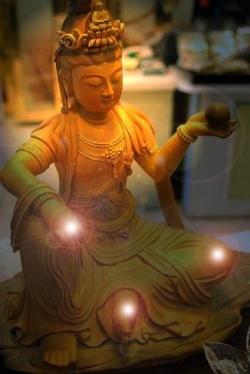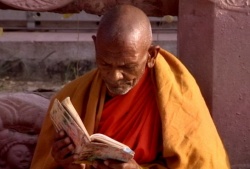The 5 skandhas by Lama Tendar Olaf Hoeyer
5 composite groups of mental processes and patterns, constituting all our experiences
symbols of the 5 Buddha families with their respective colours as they are placed in most Mandalas of Buddhist Tantra. A relation exists between the 5 skandhas and the 5 Buddha-families. In some Mandalas, the position of the Skandhas of Form and Consciousness have been switched. I have with the picture above, indicated the average relation of the 5 skandhas to each other in most Mandalas. The Vajra family (at the bottom) symbolises the skandha of form, the Jewel family (to the left) symbolises the skandha of feeling, the Lotus family (on top) symbolises the skandha of perception, the Karma family (sword) symbolises the skandha of samskara and the Buddha family (Dharmawheel in the centre) symbolises the skandha of consciousness. The Buddha families symbolise much more than just the 5 skandhas, but that is not the subject of this paper.
Skandha (Tibetan: phungpo) literally means a heap, a bundle or a collection in Sanskrit, in the meaning of composite group. Normally, it is being translated by: aggregate or aggregation. The concept of 5 skandhas describes how, what we experience, run through 5 different groups of processes in the mind. They are conceptually distinguished from each other, from the moment experiences arise in the mind, until they are being perceived consciously. So the 5 skandhas are describing the way, that our mind works. The experiences of the mind are formed step by step in each process, but this gradual development is not completely linear. These processes occur instantly, which means that they actually are almost simultaneous. So remember, that when contact appears in the skandha of form, there is instantly sense-consciousness and so forth. You will find some degree of consciousness in conjunction with all the skandhas, though there is a special skandha of consciousness, the 5th skandha. The conceptual division into 5 aggregates shows the function of each level or process, makes the development of experience conceivable and helps in the understanding of the relative ego, as well as the absolute absence of an essential Self.
These 5 different aggregates do each in their own way influence, and all together produce all our experiences. The idea of the 5 skandhas is Buddha Sakyamuni’s simple and yet complex explanation of how, all experiences are formed, and how they appear in the mind. It is one of the oldest teachings in the Buddha Dharma. This paper is very condensed, so please read it slowly and with a lot of attention, so you do not miss the points.
The 5 aggregates are:
1. FORM (Sanskrit: rupa – Tibetan: gzugs)
Skandha of Form means, that contact (Sanskrit: sparsa) occurs between sensual faculty (Sanskrit: indriya, literally meaning capacity or power) and sense object, whereby the sensual faculty is being disturbed and activated. This is how actual sensation happens. In the Dharma, sensual faculty rather than the sense organ is described, because this is, what is being experienced, when someone meditating investigates, how sensation takes place in their own mind. There are 6 sensual faculties, corresponding to 6 kinds of sense objects and 6 kinds of sense-consciousness (read the column to the right). The 6th sense-consciousness is consciousness about the mind. More on that later. Each contact occurs separately from any other contact on this level, because each sensual faculty operates independently from the others. All kinds of contact do in this way appear in some kind of form to the sensual faculties. These forms are, what is seen, heard, tasted and so on. The sense objects may originate from the World or from the mind itself, for instance as dreams. Form is called stimulus or disturbance.
2. FEELING (Sanskrit: vedana – Tibetan: tsorbha)
Skandha of Feeling means the immediate feeling of pleasure, displeasure or indifference, that is felt, when contact between sense object and sensual faculty has appeared in the skandha of form. In the same way, the skandha of feeling means attraction, rejection or neutrality - and excitement, disappointment or insensitivity and so forth. Also on this level, each feeling occurs separately from any other, because each feeling arises from each individual sensation. The skandha of feeling is the quality of the disturbance in the skandha of form.
3. PERCEPTION (Sanskrit: samjna – Tibetan: dyshe)
Skandha of Perception means the combination and recognition of the raw experiences of the various sensations and feelings, that occurred in the two previous skandhas. In the skandha of perception, they are first of all perceived in all their varieties of different kinds of sensations, that originated in various sense-fields such as sound, sight, taste and so on, combined with the various feelings, that follow each of them, and they are now for the first time perceived together in a composite perception. A complete perception of all the qualified disturbances from the skandha of form and the skandha of feeling now appears in the mind.
Secondly, this combined perception is also recognised as something already known or as something, that looks or feels like something already known. For instance, a colour is recognised as, what is called “red” and so on - or a shape now looks like a man, a woman and so forth. A holistic impression appears in the skandha of perception, where sound, taste, smell and so on fuse together in a complex package. It may be, that the food smells good, but tastes bad and looks indifferent, so all 3 qualities of the skandha of feeling may be present at the same time. Also, this raw composite experience is now recognised as “food”. The skandha of perception is the mental impression of the qualified disturbances in the skandha of form. A summary of the sense-fields, feelings and recognitions.
4. SAMSKARA (Tibetan: dy byed)
Samskara Skandha means first of all, that the events in the previous 3 skandhas now cause a reaction in the mind, generally based on our experiences from memory. Experience from memory means, that an understanding, a evaluation or a judgement about the impression, instantly presents itself on this level. Experience from memory can also mean, that a skill, a knowledge of how to handle situations, or a knowledge about how things work - already developed, habituated and memorised in the mind - manifest itself in the mind. Thereby suggesting a proper reaction or actually producing such a reaction, depending on your habits. Reaction is caused by memory of some previous experiences of a similar kind to the actual impression, that has now appeared from the third skandha of perception. So, the mind naturally reacts to the sensual or mental impression, according to your experience from memory. Samskara literally means that which has been put together and that which puts together.
This instant reaction may actually originate from several sources, depending on the nature of the impression, as it is instantly understood, judged or evaluated on this level. These sources are: the will (as a habit, Sanskrit: cetana), habits, tendencies, abilities, experiences from memory, concepts and passions. Coherence is now being created. The impression is instantly being interpreted for context. The present is now being linked to the past and the future. Until samskara skandha, the experience only existed in the here-and-now. Now, the experience is understood or misunderstood and reacted to, according to your experiences from memory.
A habit is called a samskara, habits are called samskaras in plural. So all these samskaras are the patterns by which we conceptualise our mental impressions and react, as we instantly understand, judge or evaluate these. In this way, samskaras are also our habitual patterns of action. Habitual patterns of the mind rest hidden, arise spontaneously and disappear from view again in a very particular way. They arise as sudden mirror-like reflections of meaning imposed upon the mental impression from the third skandha. They so to speak, almost live their own lives in the mind, or you could say, that samskaras exist in their own unconscious way, and make up our autobiography and our luggage for reincarnation. These patterns are the only things, that we take along with us from this life into the next, when we die - also those, that we do not like...
Samskara skandha is also translated as as: ideation, memory and mental formations. Samskaras may in general be categorised as reactionary patterns. If we have to translate the term with only one word, it will be: will, habits, tendencies, concepts, abilities, experiences from memory and passions. I therefore do not translate the word samskaras but use it as a technical term, because it covers so much. It means both composition, connection and that, which makes the connection. So it is both existing patterns in the mind as well as pattern-creation. The patterns of the mind can also be described as states of mind in the general meaning of the word, in that the concepts, passions and so on embrace the impressions from the previous skandha, and attach themselves to these. That is so, as a result of of the very mental processes themselves, based on the predetermined structure of the mind. First impression, then reaction - instantaneously, just like a light hitting a mirror reflect back at once, leaving actually no time at all for conscious intervention. You should also note, that if you want to interfere consciously, you have to get used to do it first. It will not work, if it is not a habit in itself. Formal meditation is the best method for just that.
In this way, among samskaras are also the so-called veils of ignorance (Sanskrit: avidya), karma and passion, that hide the Buddha-nature from immediate recognition, because they instantly arise in connection with any experience on this level. So samskara skandha is always distorting the impressions, until you gain insight and wisdom.
The central point of samskaras is the will (Sanskrit: cetana), that organises all the other habits, concepts, abilities, tendencies, experiences from memory and passions. Please note, that cetana is the will-as-a-habit. Cetana is of course also any ill-will, that has established itself. The free will is more or less an illusion as something completely free, because it is always based on concepts. Take for instance the concept of freedom. In this sense, samskaras are always prejudicial. Without concepts, you do not understand anything, and then you do not will anything. Then you do not know, how to understand whatever, or what to do about it. So, good and beneficial concepts and habits as well as kindness, are precious to gather and grow, because they will then become your habitual reaction.
The problematic thing about samskaras is, that we create them in a conscious effort, when we build a habit, but after that, they function on their own. Watch for instance, how very small children learn to walk. We are born with some samskaras, that define all sentient beings as well as some, that are the specific human characteristics. They kind of lie dormant in the mind as more or less unconscious tendencies and talents, and are being released into immediate reaction, when they are stimulated by the impressions from the third skandha. Unless of course, we consciously interfere and cultivate other habits, or if we consciously chose to let go of, what we usually do, and get used to do that.
Since these habitual patterns of action and conceptualisation are the reason for our way of understanding or misunderstanding our impressions, they are the cause of karma, which means our actions and their consequences, the history of our lives. What happens here, leave traces in the mind-stream (Sanskrit: santana), that runs from one moment to the next moment and so on, whereby seeds (Sanskrit: bija = seed) are formed in the mind for more or less predictable events in the future. Our experiences from memory contain all the seeds for future karma.
Samskaras are not inaccessible to us, but they work in a hidden way, and we only notice them, when they manifest by themselves as natural reactions, or we lure them to appear by artificial means. In this way, they are both unconscious luggage and potential content of the consciousness. Samskaras are also designated as mental events. That is just another way of saying mental states. There are lists of them. The common count (from Asanga) is 51 samskaras. Of course, there are many more. The 51 have to do with the work on Enlightenment. Samskaras are all the things, that we do, without thinking about, how we do it. Samskaras are both helpful and an obstacle to enlightenment.
They are not only our tendencies, talents and passions, but they are also our limitation. Every time we have to accustom ourselves to new things and new ways of doing stuff, it is a tiresome conscious effort. Once learned, habits have been formed in the mind, that free us from this attentive exercise. It is this complete dependency on habits, that limits us and makes us predictable. Without samskaras, we would not understand or comprehend anything, so we do need them, indeed. In the Dharma we also need to understand and recognise, how they work, in order to avoid their dominance, their distortion and the consequent prejudice. Samskara skandha is the reaction to the impressions of the qualified disturbances in the Skandha of Form. You will find, that samskaras are number two in the list of mutual interdependence, the 12 links of dependent origination.
(Samskaras mean something slightly different - and yet almost the same - within the Hindu religions. Particularly, it means something about the human character.)
5. CONSCIOUSNESS (Sanskrit: vijnana – Tibetan: namshe)
Skandha of Consciousness means, that the composite, interpreted and conceptualised experience is being exposed to the clarity of mind. Consciousness will be present in all the other skandhas to a degree, but normally it will first turn into full awareness, when a completely developed and conceptualised experience presents itself. As a technical term in the Dharma, consciousness is not the ability to analyse, which - as we have seen - demands quite some samskara activity. It is the bare and simple ability to know and experience. There is no prejudice about anything in consciousness itself. It is pure clarity. You do not have to produce such clarity. It is naturally present all the time in all sentient beings. It is the previous 4 skandhas, that modify and distort, what we perceive as experience. Consciousness is crucial for attention and wakefulness, but these two need habits for their base in order to work properly.
The skandha of consciousness is both the background for any actual experience and your only possibility for liberation from the dominance of your experiences, from their obsession, influence, distortion, dejection, inspiration or disappointment. Only through consciousness can mind recognise itself. In other words, if you want to transcend suffering and entertain happiness, you must ascertain this quality of clear, unstained awareness in your own mind. It is there, in spite of your natural misgivings about such clarity. Unborn or pristine clarity is your undeserved inheritance as a sentient being.
(It is due to the 3 kinds of veils, that you are unaware of the mind’s inborn clarity. These veils are those of ignorance, kleshas and karma, and they manifest in the fourth skandha, from where they arise in consciousness, along whatever else is being experienced, thus clouding and hiding mind’s pristine clarity and keeping you unaware about it. Instead of unborn clarity, you see only the veils covering and colouring the 8 kinds of consciousness)
When mind is deluded by the 3 veils, consciousness is coloured and loaded accordingly. When the veils are lifted or dissolved, consciousness will recognise it’s own nature, due to it’s pristine clarity, that is now uncovered, unhidden and unobstructed.
In modern Western psychology, very different terms are used about consciousness, so it is important to note, that consciousness as a technical term in the Dharma, means something very specific, that is the pure I-am-aware in the mind. To be aware about something. The content of consciousness is the previous 4 skandhas.
There are 8 kinds of consciousness, that conceptually correspond to their content. You can also say, that there are 8 dimensions of consciousness in experiences. First of all, there is the general mental space around and inside experiences. That is termed alaya-vijnana in Sanskrit or spaciousness of mind. Alaya means container. Vijnana means consciousness. The base aspect of mind is, that it contains all and whatever experiences. Without any effort, spaciousness of mind embrace and provide space for all experiences to unfold. Some translations read storehouse-consciousness or store-consciousness. That is so, because the samskaras along with the seeds-of-karma (sanskrit: bija) are so to speak stored in this space of mind. How this can be so, is explained elsewhere (in Asanga’s book: Abhidharma-samuccaya). For meditators, spaciousness of mind is very important in the actual insight meditation. How inactive samskaras are stored, is less important, though it is a very interesting topic. So we should note, that Asanga emphasises the kind of awareness that contains and encompass the 7 other kinds of consciousness. Mind-space, spaciousness of mind or Alaya is space-awareness. To be conscious about the presence of mental space in and around experiences.
Then secondly, there is the mind passionately attached to and identified with the World, which is termed clinging-mind (Sanskrit: klesha-citta - klesha means passionately clinging, or attachment. Citta means mind. So kleshacitta is the sticky emotional potential. As a kind of consciousness, it is called klistha-mano-vijñana, the gooey [klistha] or viscid mind-consciousness, that actualise emotional clinging and fixation). Because of passionately clinging and craving, this attachment-mind seeks, cherishes and suffers incarnation in the World. This is the tiger, that all of us ride on. It is also the source of wisdom-mind (Sanskrit: jñana, tibetan: yeshe). Please remember that. Never despise emotionality. Let go of it, while discovering the wisdom and let it be.
These two kinds of consciousness was introduced into Buddhist thinking by Asanga. In the classical pre-Asanga tradition, spaciousness of mind is regarded as Dharmadhatu, the dimension of dimensionality, and therefore not a kind of mind in itself. The kleshas (Sanskrit for passions) were correctly regarded as some special samskaras, and therefore neither any special kind of mind. Asanga introduced the concepts of these two kinds of consciousness in order to illustrate for the meditator, what needs special attention in the analytical part of insight meditation (Sanskrit: vipashyana). The clinging-mind is, what you have to let go of, and the spaciousness of mind is, what you have to hold on to. So you could say, that Asanga is the psychologist, while his critic Chandrakirti is the philosopher. Neither of them is wrong.
Finally, mind is also the 6 kinds of sense-consciousness, corresponding to the 6 kinds of sensual faculty. In the Dharma, intellect - including emotional intelligence - is termed a sense-consciousness. It is called mind-consciousness (sanskrit: mano-vidjñana, consciousness about mental forms). The sense objects for the mind-consciousness are thoughts, feelings, passions, concepts, perceptions, sensations and so on. Whatever goes on in the mind-stream (Sanskrit: santana), can be watched by the mind-consciousness.
So please note, that when you think about something, it is like a game of tennis. First a thought appears in samskara skandha as a reaction to some impressions. Then, when you start to think about it consciously, it’s formulation appears in the skandha of form. Then it is being treated in the other skandhas. After that, it may once again reappear altered, distorted or developed in the skandha of form, and again run through the other skandhas and so on. The same goes for other sensations. There is a rapid succession of ping-pongs going on in the mind-stream very very fast - all the time. One moment of consciousness, is one run through the 5 skandhas of one experience. Mind-stream (Sanskrit: santana) means, that consciousness is jumping from one such moment to the next. It is said, that there is really really nothing and no nothing in between moments, because there are no skandhas there.
(The skandhas only exists momentarily. No nothing means, that even nothingness is absent. With the skandhas absent, there are no experience, nor consciousness. Also, there is no time, because there are no movements in between moments. Because the one moment is different from the next, there is a real gap between them without time, that cannot be denied. This non-consciousness in non-time gives rise to many thoughts. You cannot experience such gaps, because they appear, when the skandhas stop. There is a kind of non-existence there).
Please note, that there are a terrible lot of such moments in just one second of time. It is mazing, how much information is handled in a split second by the wondrous jumping santana flow.
The 6 kinds of sense-consciousness are termed: nose-, ear-, tongue-, eye-, mind- and body-consciousness. The 6 kinds of sense consciousness work in the same way, whether you are dreaming or awake. Therefore it is said, that life is not a dream – it is like a dream.
So the last 7 kinds of consciousness can be regarded as the clarity aspect of mind, because through them you may experience mind’s pristine clarity, while the spaciousness of mind is the base aspect. This is the simple and basic psychology for Dharma trainees.
Conclusion
The reason that Buddha Sakyamuni taught about the 5 skandhas is for you to learn to recognise them, while you meditate. Particularly when you perform the analytical part of lhagthong - or insight - meditation (Sanskrit: vipashyana). This is the self analysis of the meditator, that corresponds to the experience of meditation. You live your life thinking that you are something, but in reality, your person is simply the 5 skandhas, the way your mind works. It is really something very universal and impersonal. All sentient beings function in this way. Since all beings always find themselves in unique and individual situations, they are always different from each other. You cannot be more person than that, even though life is maybe much more personal, than we might think or want.
By the 5 skandhas we are coupled to our surroundings. Our perceptions of the surroundings are also inside the 5 skandhas. It all happens in the present moment of consciousness, the here-and-now, that is our only chance for liberation and awareness. If we do not grab the opportunity, we will become overwhelmed by our attachments, our prejudices and habits. We will then identify with the will-as-a-habit (Sanskrit: cetana) and become victims of the unconscious processes of the mind. It does not have to be like this, but it is very difficult to avoid. It takes a long time of training and understanding to avoid being attached to our experiences and to avoid the usual identifications. Please note, that training alone is not enough. Wisdom is also needed in order to reach the path of insight, one of the 5 paths of the Dharma (read the column to the right). The point is of course, that the mind naturally liberates itself, when it does recognise itself, which it will, when all hindrances for it are removed or dissolved. The obstructions to enlightenment are the 3 veils of ignorance, kleshas and karma, along with their consequences.















